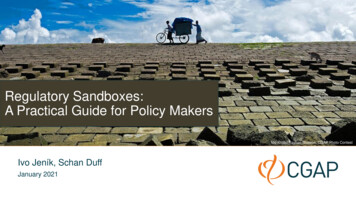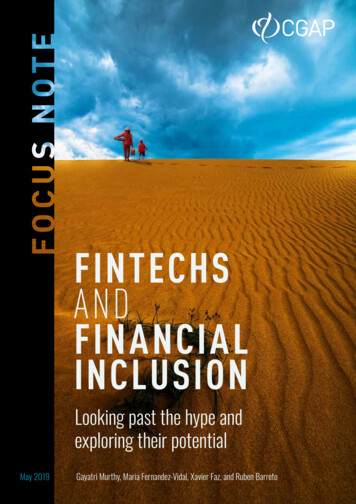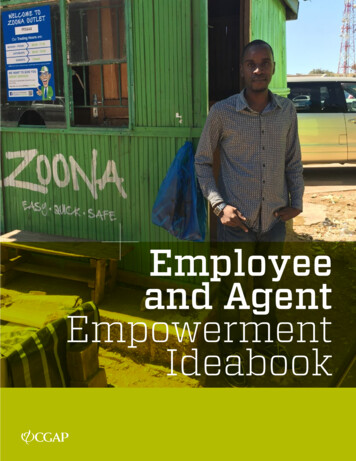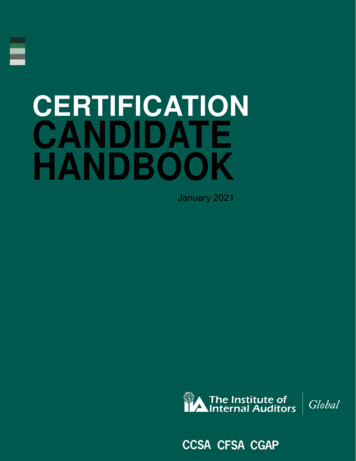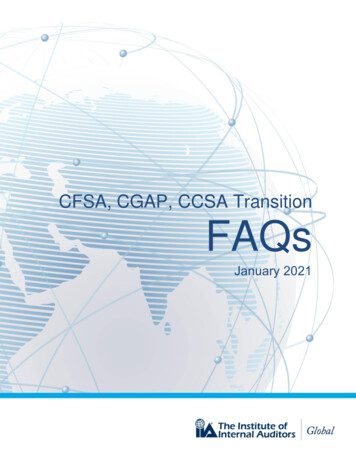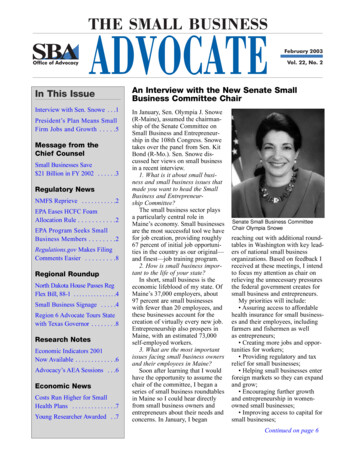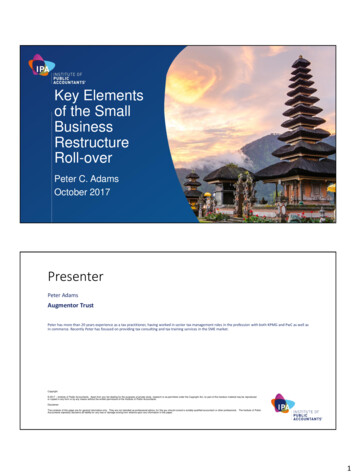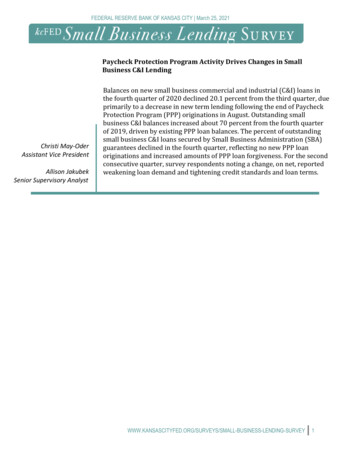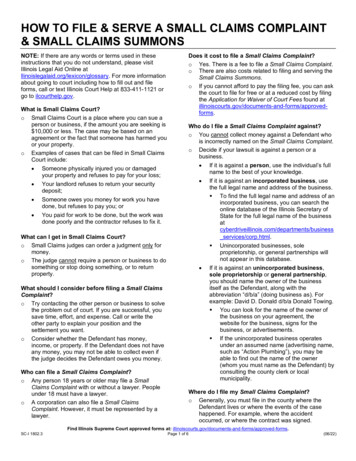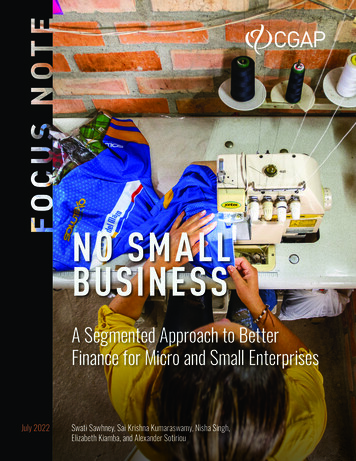
Transcription
NO SMALLBUSINESSA Segmented Approach to BetterFinance for Micro and Small EnterprisesJuly 2022Swati Sawhney, Sai Krishna Kumaraswamy, Nisha Singh,Elizabeth Kiamba, and Alexander Sotiriou
Consultative Group to Assist the Poor1818 H Street NW, MSN F3K-306Washington, DC 20433 USAInternet: www.cgap.orgEmail: cgap@worldbank.orgTelephone: 1 202 473 9594Cover photo for CGAP by Lorena Velasco via Communication for Development Ltd. CGAP/World Bank, 2022RIGHTS AND PERMISSIONSThis work is available under the Creative Commons Attribution 4.0 International Public 0/). Under the Creative Commons Attributionlicense, you are free to copy, distribute, transmit, and adapt this work, including for commercialpurposes, under the terms of this license.Attribution—Cite the work as follows: Sawhney, Swati, Sai Krishna Kumaraswamy, Nisha Singh,Elizabeth Kiamba, and Alexander Sotiriou. 2022. “No Small Business: A Segmented Approachto Better Finance for Micro and Small Enterprises” Focus Note. Washington, D.C.: CGAP.All queries on rights and licenses should be addressed to CGAP Publications, 1818 H Street,NW, MSN F3K-306, Washington, DC 20433 USA; e-mail: cgap@worldbank.org.PHOTO CREDITSPage 1: Francisco Javier Soto Plascencia/PRONAFIM, 2016 CGAP Photo ContestPages 7, 38, and 46: Photos for CGAP by Temilade Adelaja via Communication forDevelopment Ltd.Page 12: Joydeep Mukherjee, 2017 CGAP Photo ContestPage 15: Photo for CGAP by Saiyna Bashir via Communication for Development Ltd.Illustrations in Section 3 created by Gail Zuniga.
CONTENTSExecutive Summary1Section 1: Introduction7Gaps in Understanding Micro and Small Enterprises7Access to Finance for MSEs in the Digital Age9CGAP’s Focus on MSEs10Research Methodology10Section 2: MSEs, Job Creation, and Livelihoods12Definition of MSEs12MSEs and Livelihood13Section 3: Segmenting MSEs: Breaking Down the Monolith15Sector of Operation16Entrepreneurial Mindset21MSE Growth Stage26Gender of Owner30MSE Size35Section 4: MSE Segments and Finance38Insights on MSE Segments and Finance39What Can Providers Do to Reach Underserved and Excluded MSEs?42Section 5: Looking Ahead46References49Annex: Data and Research Approach50
iiAcknowledgmentsThis Focus Note has been developed from primary research commissioned by CGAP andimplemented by Dalberg Design. Field work was conducted in India, Kenya, and Peru betweenMarch and July 2021.The authors would like to thank the Dalberg team, including Stephen Morrison, Aminata Dia,Daniela Sanchez, Michael Mori, Kusi Hornberger, Tolu Odusanya, Fabiola Salman, RobertFabricant, and Ravi Chhatpar. Their patience, professionalism, and passion were fundamentalto the successful completion of the research. Special thanks to Sangeeta Sathe, whosupported Dalberg, with moderation and translation of interviews in India. Jeanette Thomasand Peter Cairns (Developing Stories) brought to life several poignant participant stories throughtheir multimedia support.The authors also extend their gratitude to M-CRIL (India) for additional ethnographic field workin India, specifically Bharti, Ashok Kumar, Mohammad Umair Khan, Rajesh Gupta, RatikaKathuria, Shreya Rajpuria, Shahanur Al Arif, Tirupathaiah Namani, Umme Tamim, Arpita PalAgrawal, Sanjay Sinha, Frances Sinha, and the late Shahid Perwez. Greta Bull (The Bill &Melinda Gates Foundation) and Timothy Ogden (Financial Access Initiatives) provided thoughtfulguidance and a patient sounding board for our ideas.Several CGAP colleagues helped shape the work, including Gayatri Murthy, who led the fieldwork implementation and provided thought leadership, and Maria Moreno-Sanchez and LeenaDatwani who provided significant research and project management support. The authorsthank Xavier Faz, Gerhard Coetzee, Claudia McKay, Jamie Anderson, and Maria FernandezVidal for their guidance and review. Jake-Anthony Pauig provided administrative supportand Andrew Johnson, Natalie Greenberg, and Jahda Swanborough provided editorial andcommunications support.Above all, we are deeply indebted to the nearly 400 micro and small enterprise (MSE) ownerswho participated in the research. We were privileged to be welcomed into their lives and tolisten to their entrepreneurial journeys, life goals, business needs, and experience navigating theworld of financial services. The research would not have been possible without their generosity,engagement, and commitment.NO SM A LL BUSINE S S: A SEGMEN T ED A PPRO A CH T O BE T T ER FIN A NCE FOR MICRO A ND SM A L L EN T ERPRISE S
1E XECUTIVE SUMMARYMicro and small enterprises, livelihoodsof low-income populations, and the needfor segmentationNearly half a billion micro and small enterprises (MSEs) in emerging markets provide livelihoodopportunities for millions of low-income populations around the world (Dalberg 2019). Access torelevant, affordable, and responsible finance remains a persistent barrier, constraining stability andgrowth for these MSEs – especially the smallest firms and those in the informal sector. Estimated ata staggering 4.9 trillion, the current unmet demand for finance reflects the limitations of traditionalfinancial services providers (FSPs) in effectively serving MSEs (IFC 2017). However, recentadvances in technology enable new digital business models that have the potential to overcomethese limitations and provide MSEs with viable solutions for increased access to finance.While the financial inclusion community has long focused on supporting MSEs, FSPs andfunders tend to view the entire MSE sector as monolithic and do not consider the diversityof firms within that universe. The result has been one-size-fits-all solutions that deal with theE X ECU TI V E SUMM A RY
2constraints felt by the entire sector. In reality, MSEs have a variety of motivations and journeys,differing financial and nonfinancial needs, and diverse experiences in accessing financialservices. This Focus Note advocates the importance of a segmented approach to addressingMSE needs and focuses on MSEs with up to 20 employees.This Focus Note is based on primary research conducted with 383 MSEs in India, Kenya, andPeru – three diverse emerging markets with a vibrant MSE finance ecosystem that includesstrong incumbent providers like microfinance institutions, cooperatives, and banks, as well asinnovative new providers like fintechs. The research profiled MSEs based on demographic andfirm characteristics, explored their attitudes toward and experiences of accessing finance, andprobed their unmet financial and nonfinancial needs. The respondents primarily came fromthe transport, manufacturing, and retail sectors, representing a significant majority of firmsin the MSE universe. The differentiated insights from the research are important for FSPs tobetter serve their MSE clients. They are also relevant to the financial inclusion community as itendeavors to rebuild the MSE ecosystem in an inclusive and resilient manner in the wake of theongoing COVID- 19 pandemic.Breaking down the MSE monolithCGAP’s research segmented MSEs into five dimensions:Sector ofOperationI.Entrepreneurial MindsetMSE GrowthStageEntrepreneur’sGenderMSE SizeS E C T O R O F O P E R AT I O NAn MSE’s choice of economic sector is shaped by its entrepreneur’s gender, socioeconomicstatus, motivation, and ability to access productive assets. The sector dimension furtherinfluences growth prospects, as well as attitudes toward formalization, digitization, and financialservices (see Figure 1).FIGURE 1.Differences in MSEs by sector of operationTransport MSERetail MSEManufacturing MSELifecycle capital High upfront, tapers laterneedsLow upfront, increases asMSE expands H igh upfront (large scale,industrial production) Low throughout lifecycle(low scale, artisanalproduction)Use of formalAt outset (vehicle serves asfinance sources asset to collateralize)Cautiously as MSEexpands A t outset (large scale,industrial production) Cautiously (low scale,artisanal production)Digital readinessHighHighLowNO SM A LL BUSINE S S: A SEGMEN T ED A PPRO A CH T O BE T T ER FIN A NCE FOR MICRO A ND SM A L L EN T ERPRISE S
3II.ENTREPRENEURIAL MINDSETCGAP’s research suggests there are two types of entrepreneurial mindsets that determinatelyaffect an MSE’s business trajectory: cautious entrepreneur and determined aspirant.While entrepreneurial mindset may be an effective way to predict preferences and behaviors,neither style is “better” than the other. Whether an individual is a cautious entrepreneur or adetermined aspirant is often a reflection of socioeconomic factors and personal circumstances.Both entrepreneur types are critical in helping the MSE ecosystem to flourish (see Figure 2).FIGURE 2.Differences in MSEs by entrepreneurial mindsetCautious entrepreneurDetermined aspirantEntrepreneur’sorientationEnterprise stabilityEnterprise growthEntrepreneur’smotivationAlternative to low-wage labor toimprove livelihoodsBuild safety net, transition from wagejob, fulfill entrepreneurial ambitionsBusiness decisionsCentered around focused andimmediate livelihood goals (e.g.,children’s education, renovatinga house)Aligned with broader goals ofadvancing family’s economic mobility,creating jobs, giving back to the localcommunity, etc.Attitude toward riskLow-risk appetite manifests asreluctance to scale, formalize, orembrace new technologiesHigh-risk appetite manifests asconstant hustle, plans to scale, seekingout new technologies to solve businessneedsAttitude towardfinancePersistent preference for informalsources, hesitant to use credit productsOpen to using formal sources over time,provided they are relevant and createvalue. Positive attitude toward andlimited-but-judicious use of creditI I I . M S E G R O W T H S TA G EAn MSE traverses at least three stages in its lifecycle: the start-up stage, the stableoperations stage, and the growth stage. Not always a linear journey, the MSE often movesbetween stages multiple times.MSEs typically start from a position of relative economic weakness and can afford to loselittle, which lowers their risk threshold in the start-up stage. Even when an MSE enters thestable operations stage, its reliance on peers and informal channels is far greater than itsreliance on formal providers. Awareness of financial and nonfinancial sources of support isshaped and improved by peer MSEs and social networks. Moreover, insufficient engagementwith FSPs at the early and stable operations stages can leave an MSE in a poor position forthe growth stage. With a lack of affordable entry points, it is left to self-finance, even thoughthe privacy and leverage of working with formal providers is preferable.I V. E N T R E P R E N E U R’S G E N D E RA gender lens is essential to better understand the motivations and contexts that influencean MSE owner’s journey and experience. It is not surprising that our research found sharpE X ECU TI V E SUMM A RY
4differences between male and female entrepreneurs in access to resources, experience withFSPs, risk appetite, experience of social norms, and growth pathways.Gender norms often push women to prioritize household responsibilities. These same norms,however, enable many women to choose operating a business over wage employment as itallows them to undertake an economic activity that includes flexibility around the use of their time,efforts, and work. On the other hand, a woman entrepreneur’s choice of sector is often influencedby these norms and sometimes limits income opportunities. CGAP research suggests thatwhile some women start businesses to support their families, many do so to achieve economicempowerment and independence. Thus, they are often motivated to seek funding from outsidethe family to preserve autonomy.We found that women entrepreneurs seek stability in FSPs and demonstrate a preferencefor providers with female representation among their staff, client base, and marketingcampaigns. More digitally savvy women entrepreneurs perceived greater safety when usingdigital solutions for commercial exchanges rather than face-to-face interactions with malecounterparts. This finding suggests the potential for early adoption of digital financial services(DFS) by women entrepreneurs.V.MSE SIZEMost MSEs do not expand or grow into large businesses for multiple reasons, including a lackof access to finance, technology, markets, and human capital. CGAP’s research suggests thatan MSE’s size is often associated with its owner’s socioeconomic status, level of education,and social networks. MSEs that are larger at inception tend to be inherited family businessesor set up by entrepreneurs from advantaged socioeconomic backgrounds. Conversely, ownerrun MSEs or those with few employees are often conceived on a small scale as an alternativeto unstable employment. Additionally, growth in smaller MSEs is often via the creation of aportfolio of several small businesses rather than the growth of one business – led by the desireto diversify sources of income and manage the risk of putting all efforts and resources into asingle enterprise.Evidence also suggests that a business’s size may be a good indicator of preference forformal vs informal finance, with smaller firms preferring the speed and lower collateral needs ofinformal finance. Conversely, larger MSEs tend to seek formal finance, particularly for growth.They have clear expectations on how providers should meet their needs.Attitudes toward financePERSISTENT PREFERENCE FOR INFORMAL FINANCEMSEs across segments reported a strong preference for informal over formal finance forseveral reasons. In their experience, formal FSPs demonstrate little or no trust and flexibility,while informal providers extend timely and affordable financing on flexible terms – with lowerdocumentation and collateral requirements.NO SM A LL BUSINE S S: A SEGMEN T ED A PPRO A CH T O BE T T ER FIN A NCE FOR MICRO A ND SM A L L EN T ERPRISE S
5CGAP research suggests that MSEs, especially those in the stable and growth stages, areoften loyal users of formal personal finance (e.g., savings accounts, term deposits, credit, debitcards). However, many enterprises find that loyalty does not result in increased or better accessto finance due to excessive collateral requirements and the continued rejection of business loanapplications.Furthermore, while financial illiteracy is often cited as a reason MSEs cannot access finance,their exclusion is likely a result of the use of jargon and lackluster communication fromFSPs that presents barriers to entry and excludes potentially responsible, growth-orientedcustomers.D I G I TA L F I N A N C E S K E P T I C SMost MSEs are unwilling early adopters of digital finance. The recent proliferation of theuse of digital payments is more in response to COVID-19-related mobility restrictions andevolving customer and supplier preferences. MSEs remain reluctant adopters of many of thetechnologies their businesses rely on, especially if they lack agency and control over thosetechnologies.A deep-seated trust deficit in providers – especially DFS providers – continues to be a dominantbarrier to increased uptake of formal finance by MSEs. Digital channels exacerbate the trustdeficit due to the limited number of recourse mechanisms users have to enforce their rights. Lackof transparency on the use of customer data also remains a recurring concern.Nevertheless, MSEs need formal financial services to accelerate growth and strengthenresilience. FSPs with a strategic inclination to serve MSEs can address these concerns byconsidering changes to their service approach for different MSE segments, including tailoredservices, greater trust built through increased transparency and clear communication, andstrengthened recourse mechanisms with more human touchpoints.Implications for the financial inclusion communityThe devastating health and economic effects of the COVID-19 pandemic havedisproportionately impacted MSEs, especially the smallest, women-owned, and informal-sectorfirms. However, one silver lining has emerged: the increased adoption of digital technologiesby MSEs that were pushed to seek ways to keep commerce flowing during restrictions andlockdowns. Beyond operational efficiencies, MSEs that embrace digitization have the potentialto access alternative forms of finance, streamline payments, and obtain new forms of insurancecoverage. Digitization helps create small digital trails and alternative data that lenders can useto evaluate credit risk more effectively.Rebuilding the livelihoods of millions of low-income populations and fostering resilience againstfuture economic shocks requires both financial and nonfinancial support to the MSE ecosystem.But any support effort should begin by acknowledging the diversity within the MSE universeand embracing a segmented approach. It also requires the coordinated effort of several keystakeholders (see Figure 3).E X ECU TI V E SUMM A RY
6FIGURE 3. The role of stakeholders in rebuilding a resilient digital MSE finance ecosystemFinancial inclusion funders P rovide patient capital to MSEfocused DFS providers S upport further research focusedon segmentation of MSEs in othermarkets C onvene stakeholders to facilitateknowledge exchangeDevelopment finance institutions(DFIs) and other investors P rovide targeted financial supportto DFS providers serving excludedMSEs in frontier markets D eliver technical assistance to DFSproviders to support customersegmentationDFS providers C ollaborate with the researchcommunity to identify barriers toaccess, especially those related togender and social norms I ntegrate segmentation with theorganization’s strategic prioritiesSector support organizationsRegulatorsResearchers U ndertake advocacy and capacitybuilding for MSE segmentation N urture an enabling regulatoryenvironment that balances DFSinnovation and customer protection C onduct further research on howbest to profile MSEs and validatethe need for a segmented approach C reate safeguards to protect newto-digital customers from fraudand abuse U ndertake further impact researchon MSEs and their owners on thebenefits of tech-enabled finance Conduct communicationscampaigns to increase MSE digitaland financial literacy C larify linkages and channels ofimpact – from enterprise to theimproved livelihoods of lowincome populations – and the roleof finance Support communicationscampaigns and digital/financialliteracy programs to increaseMSE awareness of, trust in, andcapacity to use DFSNO SM A LL BUSINE S S: A SEGMEN T ED A PPRO A CH T O BE T T ER FIN A NCE FOR MICRO A ND SM A L L EN T ERPRISE S
7SECTION 1INTRODUCTIONGaps in UnderstandingMicro and Small EnterprisesMicro and small enterprises (MSEs) are important and valuable livelihood sources forlow-income households in emerging markets. Through self-employment, MSEs create jobs fora large proportion of the world’s poor population. CGAP and Dalberg research estimates thatnearly 500 million MSEs exist in emerging markets, with Sub-Saharan Africa and South Asiaaccounting for half (Dalberg 2019). Eight-six percent of MSEs in emerging markets are microenterprises with fewer than 10 employees. A vast majority have only one worker: the owner. Asmall number (approximately 86 million) employ up to 50 people. These MSEs are consideredsmall enterprises.Although usually quite small, MSEs play a disproportionately large role in the economies ofdeveloping countries, with firms of 5–19 employees contributing to as much as 50 percentINTRODUC TION
8of net job creation (Ayyagari et al. 2014). Although MSE owners generally create jobs fortheir household members rather than paid employment for outsiders, the sheer number oflow-income populations in emerging markets positions the MSE sector as a critical driver forsustainable livelihoods. For many, it is often the only viable alternative to unemployment.Given its significance for low-income populations and overall economic development, theinternational development community has long focused on the MSE sector. Yet much ofwhat we know about MSEs remains theoretical; important knowledge gaps still exist. Despitedecades of research, little is known about the unique characteristics of MSE owners, thetrajectories of their businesses, and the role financial services play in supporting MSE ownersand employees. Moreover, while research on microenterprises is extensive, it often relies ondata such as the World Bank Country Indicators and Enterprise Surveys that exclude from theirsample very small enterprises with fewer than five employees and informal enterprises, wheremuch of the world’s poor population is concentrated. Consequently, insights on how MSEssustain and expand livelihoods are based on the experience of larger, more formal MSEs whilesmall, informal, and the poorest MSEs often remain excluded.Significant knowledge gaps persist with respect to the smallest MSEs. Some salient gapsrelate to the productivity factors most relevant to them, the mindsets and strategies prevalentamong owners and the motivations behind them, and, most importantly, the remainingunmet needs across different types of MSEs. Gaps mainly persist because information aboutlarger firms is easier to access and the general belief that greater productivity – and thereforegreater impact – lies with larger firms. Although the productivity and growth emerging throughsupport to larger enterprises is important for overall economic development, an equallycogent argument can be made for focusing on sustainable livelihood generation and reducedlevels of unemployment through smaller firms. Although often not growth-oriented, smallerfirms provide low-income populations with stable employment and reliable livelihood support.They are a steppingstone toward reduced poverty – the ultimate focus of most economicdevelopment activity. It is imperative to take a balanced approach that also considers theneeds of the smallest MSEs in the ecosystem.A related and critical gap is the limited understanding of the details and nuancesof segments that make up the larger universe of MSEs: firms with fewer than20 employees. These firms are the focus of this paper. To better support these MSEs,it is important to understand how their journeys are impacted by the number of employeesin the firm, gender and socioeconomic status of the firm’s owner, entrepreneurial mindset(linked to gender and socioeconomic status), and business sector, among other attributes.Differentiating firms by these variables and taking a granular and segmented approachtoward MSEs with fewer than 20 employees can provide valuable information for designingand implementing targeted support efforts. This is particularly significant at a time when thedevelopment community seeks solutions to rebuild the MSE ecosystem and promote greatereconomic resilience in the wake of the ongoing COVID- 19 pandemic.NO SM A LL BUSINE S S: A SEGMEN T ED A PPRO A CH T O BE T T ER FIN A NCE FOR MICRO A ND SM A L L EN T ERPRISE S
9Access to Finance for MSEs in the Digital AgeAccess to finance is long recognized as an enabler of growth for MSEs globally. While resultsfrom studies on increased access to finance for MSEs are mixed and suggest potentiallymodest impact, it is strongly recognized that access to adequate and timely financialservices goes a long way toward increasing resilience, stability, and growth opportunitiesfor MSEs and, consequently, higher incomes and job security for low-income households(Kumaraswamy 2021).The International Finance Corporation (IFC) estimates the global demand for credit from MSEsin emerging markets at approximately 8 trillion, with 30 percent of demand coming fromMSEs in the informal sector. At 3.94 trillion, credit demand is highest in East Asia, followed by 1.6 trillion in Latin America (IFC 2017).Despite the enormous demand for credit, traditional finance mechanisms continue tounderserve MSEs. The remaining 4.9 trillion finance gap constrains growth and employmentfor low-income households (see Figure 4).The barriers to providing financial services to MSEs in emerging markets historically include: The high cost of customer acquisition and assessment Insufficient or inaccurate data to make accurate credit assessments Low lifetime customer value due to small loan sizes and short loan tenors Limited opportunities to cross-sell The high costs of distribution and servicingFIGURE 4.Estimated global MSE credit gap (in USD sesCredit DemandFormal SmallEnterprisesCredit DemandSource: Dalberg (2019) and IFC (2017)INTRODUC TIONInformalMicroenterprisesCredit DemandInformal SmallEnterprisesCredit DemandTotal MSECredit DemandTotal MSECredit SupplyUnmet MSECredit Demand
10Technology-enabled business models demonstrate significant potential to revolutionize MSEfinance, particularly for firms with fewer than 20 employees that previously were too small, toocostly, or too complex for traditional financial sector players to serve. The opportunity existsfor incumbent financial institutions focused on providing productive finance to MSEs (e.g.,microfinance institutions, financial cooperatives, credit unions, others) to adapt their existingbusiness models to the emerging digital ecosystem. This allows those providers to serve newand existing customers more effectively. New entrants into the ecosystem, such as fintechstart-ups, will also find the opportunity to create entirely new business models that help themserve a part of the market that is not served by others and is potentially difficult for incumbentsto replicate. A deep understanding of several segments within the MSE universe is necessaryand useful to either of these types of FSPs.CGAP’s Focus on MSEsTo better understand the characteristics and the financial/nonfinancial needs of MSEs –particularly those with fewer than 20 employees – CGAP conducted primary research withMSEs in India, Kenya, and Peru. The research methodology consisted of surveys, in-depthinterviews, and focus group discussions designed to:1. Understand the various factors affecting livelihood and income generation across differentMSE segments2. Examine the role of financial and nonfinancial services in supporting MSE livelihoods3. Recommend ways in which FSPs, particularly DFS providers, can tailor their approach andofferings to better address the needs of MSEsDetails of the primary research methodology and sample structure can be found in the Annex.This Focus Note presents a differentiated understanding of firms with fewer than20 employees by first proposing key variables for effective segmentation, then describing howeach MSE segment has different financial and nonfinancial needs, attitudes, preferences, andpriorities. It also discusses how these differences impact the journey and growth trajectoryof MSEs, and how this knowledge can be used to serve MSEs more effectively within thefinancial sector and improve access to finance for underserved and excluded MSEs.Research MethodologyThis Focus Note is based on primary research with 383 MSEs in India, Kenya, and Peru. Theresearch methodology consisted of rapid online surveys, in-depth interviews (some conductedin-person, some remotely by video), and small group discussions. We adopted a convenienceand snowball sampling approach, intentionally structuring the sample to cover MSEs of allsizes across three sectors, including women-owned MSEs. The sample consequently is notrepresentative of the underlying population.NO SM A LL BUSINE S S: A SEGMEN T ED A PPRO A CH T O BE T T ER FIN A NCE FOR MICRO A ND SM A L L EN T ERPRISE S
11Insights presented in this paper are qualitative in nature and should be interpreted assuch – and with caution. The goal is by no means to provide a definitive or comprehensivesegmentation of MSEs in these markets. The purpose of the research and the paper isto demonstrate the diversity that exists within the MSE universe. It also underscores theimportance of what we can learn by taking a segmented approach to a financially underservedand excluded population that is far too often perceived as a monolith by both providers andfunders. Further research in this space is warranted and necessary.A NOTE ON TERMINOLOGYThe terms formal finance and informal finance are often mentioned throughout this paper.Formal finance refers to sources of finance within the organized financial sector whoseproviders are regulated, such as banks, microfinance institutions, and DFS lenders. Informalfinance refers to sources of finance outside the organized financial sector, including quasiformal providers that are either less regulated or wholly unregulated. Examples include family,friends, neighborhood moneylenders, neighborhood savings groups, and rotating savings andcredit associations.Similarly, the term digitization (including but not limited to digital finance) is broadly used torefer to the use of digital tools and technologies to conduct business operations. It includesthe use of e-commerce websites and social media like WhatsApp, Facebook, and Instagramfor marketing and customer relationship management, and the use of computer software andmobile apps to maintain account and inventory books. It also refers to the use of DFS, such asdigital payments, mobile money wallets, digital savings, and credit.S T R U C T U R E O F T H E PA P E RThe remainder of the paper is structured as follows: Section 2 highlights the importance of MSEs to the livelihoods and resilience strategies oflow-income households in emerging markets, particularly as related to local communitiesand disadvantaged populations. Section 3 breaks down the monolithic MSE sector to portray the great diversity within theuniverse of firms with fewer than 20 employees. It describes their unique characteristics andbehaviors across demographic variables and firm characteristics. Section 4 explores MSEs’ attitudes toward finance: how th
Elizabeth Kiamba, and Alexander Sotiriou. 2022. "No Small Business: A Segmented Approach to Better Finance for Micro and Small Enterprises" Focus Note. Washington, D.C.: CGAP. All queries on rights and licenses should be addressed to CGAP Publications, 1818 H Street, NW, MSN F3K-306, Washington, DC 20433 USA; e-mail: cgap@worldbank.org.
